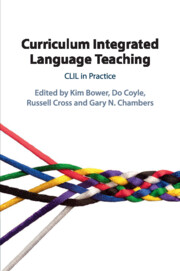Book contents
- Curriculum Integrated Language Teaching
- Curriculum Integrated Language Teaching
- Copyright page
- Contents
- Figures
- Tables
- Contributors
- Foreword
- Preface
- Acknowledgements
- Part I The Educational Context for CLIL
- 1 CLIL in Multilingual and English-Background Contexts
- 2 How Can Learners Be Motivated in a Context of Demotivation for Foreign Language Learning?
- 3 A Rationale for CLIL in Primary Schools
- Part II Current Aspects of Practice in CLIL
- Part III New Knowledge and Future Directions
- Afterword
- Index
- References
1 - CLIL in Multilingual and English-Background Contexts
Expanding the Potential of Content and Language Integrated Pedagogies for Mainstream Learning
from Part I - The Educational Context for CLIL
Published online by Cambridge University Press: 27 July 2020
- Curriculum Integrated Language Teaching
- Curriculum Integrated Language Teaching
- Copyright page
- Contents
- Figures
- Tables
- Contributors
- Foreword
- Preface
- Acknowledgements
- Part I The Educational Context for CLIL
- 1 CLIL in Multilingual and English-Background Contexts
- 2 How Can Learners Be Motivated in a Context of Demotivation for Foreign Language Learning?
- 3 A Rationale for CLIL in Primary Schools
- Part II Current Aspects of Practice in CLIL
- Part III New Knowledge and Future Directions
- Afterword
- Index
- References
Summary
Chapter 1 outlines the peculiarities of language learning in predominantly Anglophone contexts, highlighting the challenges that Anglophone countries face in the teaching of modern languages compared to non-Anglophone countries. Tracing the development of Content and Language Integrated Learning (CLIL) in the United Kingdom and Australia, the chapter explains why CLIL in such contexts is most often taught by language specialists, in contrast to content-area specialists, as is often the case in Europe where CLIL has been established for much longer. The chapter considers how CLIL offers a pedagogic model for mainstream modern language teachers in Anglophone-dominant contexts and how the same professional knowledge base might also have the potential to support the teaching of English as an additional language (EAL). The origins of how CLIL globally has become synonymous with learning English are also traced. A research agenda around the themes of sustainability, pedagogy, and social justice for CLIL in Anglophone-dominant contexts is proposed.
- Type
- Chapter
- Information
- Curriculum Integrated Language TeachingCLIL in Practice, pp. 3 - 21Publisher: Cambridge University PressPrint publication year: 2020
References
- 6
- Cited by



